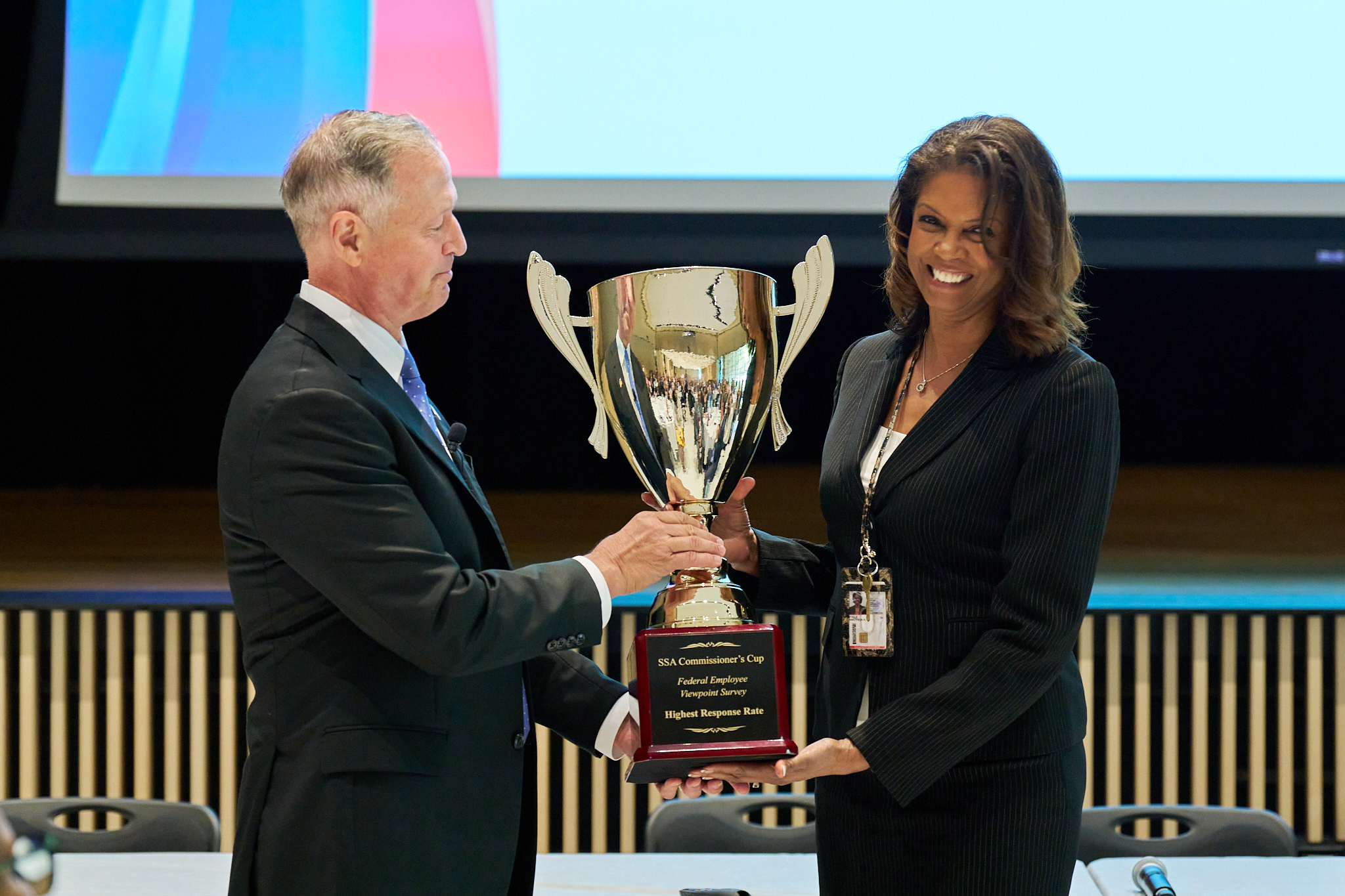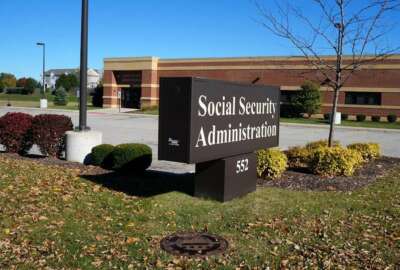Exclusive
For SSA workforce, 2024 FEVS results show promising signs
Along with positive trends in the survey results, SSA saw a jump in its response rates for the 2024 FEVS, with 70% of SSA employees taking the survey this year.
After a long road of trying to improve workforce morale, the Social Security Administration finally appears to be turning a corner.
For the first time in years, SSA employees’ views on employee engagement, satisfaction and agency leadership are all trending positively, according to SSA’s results of the 2024 Federal Employee Viewpoint Survey (FEVS), shared exclusively with Federal News Network.
The FEVS employee engagement index, which tracks whether a federal workplace has the right factors for fostering engaged workers, was one notable area of increase for SSA in this year’s survey results. The agency increased its engagement index score from 65% positive responses in 2023, to 68% positive results in 2024.
Additionally, for the relatively new FEVS employee experience index, which measures how much a work environment actually fosters positive engagement, SSA’s score increased from 67% to 69% between 2023 and 2024.
“The feedback that we’re getting in those two complementary indices is really telling us that what we’re doing is reinforcing the environment in SSA and making it more conducive to employee engagement,” SSA Acting Deputy Commissioner for Human Resources Kristen Medley-Proctor said in an interview. “We see that in particular in our frontline components — our operational components that are serving the public every day — which is really important, because there’s that connection between employee engagement and customer experience as well.”
The positive trends in the 2024 FEVS come after years of declining scores for the agency. SSA ranked last place for large agencies in the 2023 Best Places to Work in the Federal Government rankings from the Partnership for Public Service.
Broader survey data to compare SSA’s 2024 results against other agencies governmentwide is not yet publicly available. The Office of Personnel Management, which administers FEVS annually, is expected to release preliminary results of the 2024 FEVS in the coming weeks.
Response rates for SSA at all-time high
Along with the positive trends in the survey results, SSA also saw a massive jump in its response rates for the 2024 FEVS: 70% of all SSA employees took the 2024 survey. It’s an increase of 24% over SSA’s 46% response rate in 2023, marking the highest FEVS response rate for SSA in recent memory. By comparison, the 2023 FEVS received a governmentwide response rate of 38%.
To reach the high response rates, SSA launched an agency-wide marketing campaign, led by SSA Commissioner Martin O’Malley, to encourage participation and get the word out about the survey. During the campaign earlier this year, O’Malley recorded and shared video messages with employees, and joined various staff meetings to personally ask employees to fill out the survey.
The agency also created a “response rate challenge,” where SSA components held a friendly competition to see who could earn the highest and the most improved response rates. O’Malley then awarded the winning components with a “commissioner’s cup” trophy.

Dustin Brown, SSA’s chief operating officer and acting chief of staff, said he was “blown away” by the response from SSA’s workforce this year.
“I saw videos of people doing the Ice Bucket Challenge out in Tennessee, people shaving ‘FEVS’ into their hair, getting a pie in the face — all sorts of different, creative things that this agency was willing to do when they were given an ambitious goal to go after,” Brown said. “I think that says a lot about this agency and how committed employees are.”
The 70% FEVS response rate was also the culmination of months of other efforts from senior leadership, encouraging agency staff across the country to submit their ideas and comments for how to improve SSA overall.
“We know that encouraging people to respond to the survey is really just the first step,” Medley-Proctor said. “The most important part is when we get the results, we have to analyze the feedback, and then we have to take action on the feedback.”
SSA looking to address “unreasonable” workloads
One major concern the Social Security Administration is continuing to grapple with is high workloads for staff members. Many employees in surveys over the past several years have said they feel their workloads are unreasonable.
SSA leaders have said the challenging workloads stem from low agency staffing levels and limited resources, coupled with a quickly rising number of Social Security beneficiaries.
“In previous surveys, SSA employees rated themselves as the most exhausted workforce in government,” Brown said. “We definitely see that challenge in terms of the lowest staffing levels in 50 years and the highest number of customers really taking its toll on the workload of the front lines. It’s one of the reasons we are so focused on that issue.”
Moving forward, Medley-Proctor said the agency is “looking at how we can improve processes, how we can improve technology and how we can make the environment easier for employees to manage their workloads.”
“To me, that’s the crux of it,” Medley-Proctor said. “There are a lot of programs that we can put out there. There are a lot of things that we can do for work-life balance and flexibilities for employees. But their workloads really are what make their experience throughout the day resonate with them.”
In an effort to address common management challenges at the agency, SSA launched a “Security Stat” initiative earlier this year. Every other week, O’Malley holds “Security Stat” meetings to review performance metrics and identify actions for progressing toward better customer service. In part, the initiative aims to mitigate high workloads of SSA employees.
“Those meetings give us the opportunity, as a leadership team, to try to chip away at that specific issue, which is employee workloads and their ability to deliver service,” Medley-Proctor said.
Views of agency leadership turning a corner
In the 2024 FEVS results, Social Security Administration employees’ perceptions of immediate supervisors earned the highest score of any FEVS index. The agency received 77% positive responses in how employees view their supervisors and managers. For higher level leadership, a category that’s typically lower governmentwide for federal employees’ scores, the FEVS index still increased by 5% for SSA, going from 55% to 60% between 2023 and 2024.
“This was really the highest level of positive responses to that particular index that we’ve seen in at least the past five years,” Medley-Proctor said. “This was also our largest increase this year, and it really means a lot to us because it affirms all the work that we’ve been doing to support the leadership team.”
In one of the more modest increases that SSA saw in its FEVS results this year, global satisfaction of federal employees increased by 1% since 2023. But for Medley-Proctor, the relatively small bump is still a promising sign for the agency.
“It was only one percentage point, but it is a step in a positive direction, because we have had substantial declines in that score [in past years],” Medley-Proctor said. “We were at 65% in 2020, [and] we dropped to 52% in 2023. Now, we feel like we’re back on the upswing, because this is the first time we actually saw an improvement and an increase here … Although we have a lot of room to improve, we’re just pleased that we’re back on this positive trajectory.”
Even in light of the improvements, SSA leaders still see the 2024 FEVS results as a “starting point.”
“It’s going to need to be a multi-year approach, because with an organization as large as SSA is, it takes time and intention to turn that ship around,” Medley-Proctor said. “We think we’re there — we’re turning it around — but there’s still more to do.”
Copyright © 2025 Federal News Network. All rights reserved. This website is not intended for users located within the European Economic Area.
Drew Friedman is a workforce, pay and benefits reporter for Federal News Network.
Follow @dfriedmanWFED






